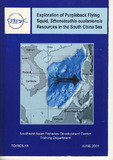| dc.description.abstract | In an attempt to come up with initial jigging fishery on the purpleback flying squid, Sthenoteuthis oualaniensis in the Southeast Asia region, SEAFDEC has conducted the survey on resources and fishing ground conditions of the squid in the South China Sea. The survey objective are to determine distribution and abundance of the purpleback flying squid in relation to oceanographical conditions and to examine the feasibility of harvesting squid with jig gear. In addition, the author reviews cephalopod fisheries in Southeast Asian countries as a whole against total landings of marine group of species, i.e., squids, cuttlefishes and octopus. Details are provided on species caught, Statistic data by species, by group and by countries, fishing gear types and perspective of fishing from the viewpoint of technological aspect.
Based on statistical data from 1976 to 1994 the amount of cephalopods caught in the region steadily increased from 83, 692 tons in 1994. Thai fishermen caught about 50% of this total catch in 1994, the rest 20% and 18% being the Philippines and Malaysia, respectively. More than 50% of the catch is generally composed of squid. 9 groups of fishing gears: surrounding net, seine net, trawl, gill net, life net/cast net, trap/stake, hook and line, push/scoop net and miscellaneous gears are employed for catching the cephalopods. Trawl fisheries in Malaysia, Thailand and the Philippines caught about 88%, 70% and 44% of the total catch for 1994, respectively.
Exploration of the S. oualaniensis resources and its fishing ground were conducted by using MV SEAFDEC of the Southeast Asia Fisheries Development Center. The survey area in the South China Sea was divided into three areas, namely Area I: Western Philippines Waters, Area II: Vietnamese Waters, and Area III: Sabah Sarawak (Malaysia) and Brunei Darussalam Water, of which the surveys were in the exclusive economic zones of each country, respectively. Four automatic squid jigging gears with luring light system were employed for catching the squid. Catch per unit effort (CPUE: the number of squids per line-hour) is used an index of abundance for a fishing ground. 30 squid sampling and 117 oceanographic stations were carried out during March-May of 1998-2000. Water temperature, salinity, dissolved oxygen, chlorophyll and other parameters were measured at all stations to elucidated oceanographic features of the research area. At each station, squid larvae surveys were also conducted.
A total of 4,257 S. oualaniensis specimens, capture were consisted of 2,592 specimens from the Western Philippines, 1,412 specimens from Vietnamese waters, and 253 specimens from the Sabah, Sarawak (Malaysia) and Brunei Darussalam waters. Mantle length of the S. oualaniensis capture within each survey area was 90-250 mm,90-240 mmand 58-230 mm, respectively. Female dominated the catch, accounting for about 81% of the total squid. Males were generally smaller than females of which their mantle length range was 90-180 mm. CPUEs of the S. oualaniensis were 0.15-18.47 ind./line-hour in April-May. High CPUEs were located in the EEZ of the Philippines off Currimao and San Fernando (17°-18°N and 117°-119°E) and in the EEZ of Vietnam off Danang (15°N and 111°E). Drop-off rates for jigs fished by the jigging machines ranged from 0 to 0.33 squid/line-hour. Angling depth where the squid were abundant ranged from 50 m to 100 m.
S. oualaniensis distributed in the warm water mass whereas the sea temperature ranged from 14°c to 31°c within the depth from 150 m up to the sea surface at night. Good fishing grounds of the squid were at the area of 17°N, 117°E and 18°N, 119°E, of which seasonal upwelling was found at the later. Dissolved oxygen at abundant area was 3.27 to 4.4 ml/l. Downwelling was found at 16°N, 118°E where less potential of squid, the water transparency depth was observed to be 44 m. Another upwelling was also observed within the EEZ of Vietnam at 14°N, 111°E during May. Cephalopod paralarvae were collected at most stations on the shelf and shelf edge of the South China Sea basin where the bottom topographical depth are deeper than 150 m. | en |

